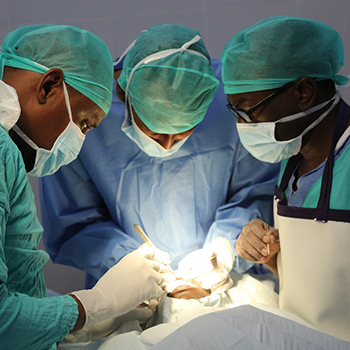Craniofacial surgery is a subspecialty of plastic surgery that focuses on the reconstruction and correction of facial deformities and injuries. It involves repairing and reconstructing the bones, skin, and soft tissues of the face and skull to restore normal function, aesthetics, and symmetry. Craniofacial surgeons treat a range of conditions, including cleft lip and palate, craniosynostosis (abnormal fusion of skull bones), facial trauma, and birth defects. The procedure often involves a multidisciplinary approach, involving collaboration with other specialists such as neurosurgeons, otorhinolaryngologists, and orthodontists. The goal of craniofacial surgery is to improve the patient's quality of life, self-esteem, and overall well-being.
a. Craniosynostosis Repair
Craniosynostosis repair is a surgical procedure that corrects the abnormal fusion of the bones of the skull, which can occur due to a congenital condition. The procedure aims to restore the normal shape and structure of the skull, improving the appearance and function of the head and face. The surgery involves opening the fused bones, repositioning them, and securing them with plates and screws. The procedure is typically performed on children under general anesthesia, and the goal is to achieve a normal-appearing skull shape and reduce any associated symptoms such as increased intracranial pressure or breathing difficulties.

b. Orthognathic Surgery
Orthognathic surgery is a type of maxillofacial surgery that involves the correction of dental and facial deformities by reshaping and repositioning the jawbone. The procedure aims to improve the alignment of the teeth, jaws, and face, which can alleviate various conditions such as malocclusion, TMJ disorders, and facial asymmetry. Orthognathic surgery can be performed on both children and adults, and is typically done under general anesthesia. The procedure involves making incisions in the gums and jawbone to reposition the bone, followed by a period of recovery and orthodontic treatment to achieve optimal alignment.
c. Facial Trauma Reconstruction
Facial trauma reconstruction is a surgical procedure that aims to restore the natural appearance and function of the face after an injury or accident. This can include repairing broken bones, reattaching severed skin and tissue, and rebuilding damaged facial structures such as the nose, ears, or jaw. The goal is to restore the patient's facial aesthetics and enable normal facial functions like eating, speaking, and breathing. Facial trauma reconstruction requires a team of specialists including plastic surgeons, oral-maxillofacial surgeons, and otolaryngologists. The procedure typically involves multiple stages, including initial stabilization, reconstruction, and subsequent follow-up surgeries to achieve optimal results.
d. Cleft Lip and Cleft palate surgery
Cleft lip and palate surgery is a reconstructive procedure aimed at correcting congenital defects in the mouth and facial structure. A cleft lip occurs when the lip does not form properly during fetal development, resulting in a gap or separation between the two sides of the lip. A cleft palate occurs when the roof of the mouth does not form correctly, causing an opening in the soft palate or hard palate. The surgery typically involves a multidisciplinary team of experts, including plastic surgeons, orthodontists, and speech therapists. The procedure involves a series of surgeries, usually starting in early infancy. For a cleft lip, the surgery involves closing the gap and reshaping the lip to create a normal appearance. For a cleft palate, the goal is to close the opening and improve speech and eating functions. The surgery can significantly improve the appearance and functionality of the mouth, allowing individuals with cleft lip and palate to lead normal lives with minimal complications.
e. Blepharoplasty
Blepharoplasty, or eyelid surgery, removes excess skin, fat, and muscle to rejuvenate the eyes. It reduces bags, puffiness, and sagging, and can be done on the upper or lower eyelid. The procedure involves incisions in natural creases, and recovery typically takes a week, with temporary swelling, bruising, and dry eyes.
f. Orbital Reconstruction
Orbital reconstruction is a complex surgical procedure that aims to restore the shape and function of the orbit, the bony socket that contains the eye. This can be necessary after traumatic injuries, tumors, or congenital defects that damage the orbit. The procedure typically involves removing damaged bone and tissue, and rebuilding the orbit with grafts or implants to restore its shape and structure. The goal is to achieve proper eye alignment, improve vision, and reduce facial asymmetry. Orbital reconstruction requires expertise in both ophthalmology and craniofacial surgery, and may involve multiple procedures to achieve optimal results.


